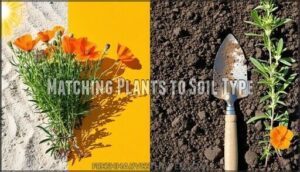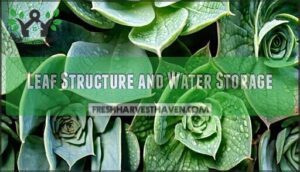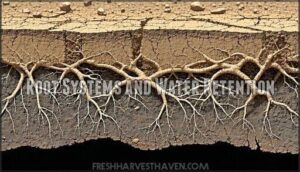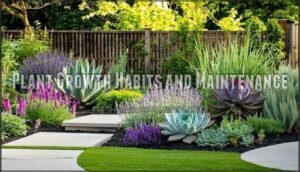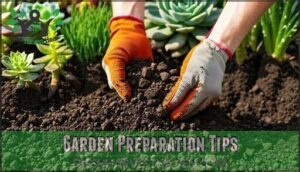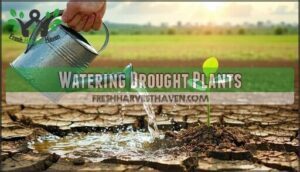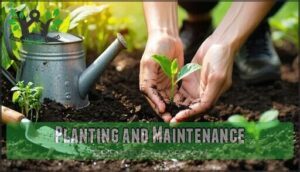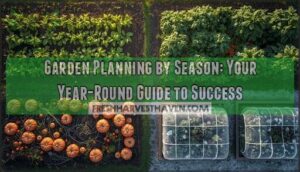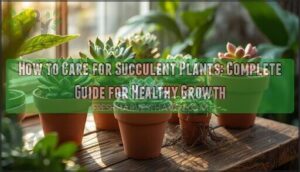This site is supported by our readers. We may earn a commission, at no cost to you, if you purchase through links.
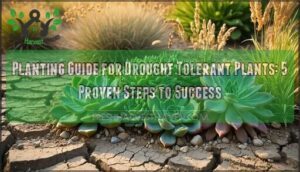 Creating a successful planting guide for drought tolerant plants starts with choosing the right species for your climate zone and soil conditions.
Creating a successful planting guide for drought tolerant plants starts with choosing the right species for your climate zone and soil conditions.
You’ll want plants with thick, waxy leaves or succulent tissues that store water naturally.
Focus on native varieties—they’re already adapted to your local rainfall patterns and won’t throw tantrums during dry spells.
Prepare your soil with good drainage and organic matter, then plant during cooler months when roots can establish without stress.
Water deeply but infrequently to encourage strong root development.
The magic happens when you understand that these resilient beauties actually prefer being slightly neglected.
Table Of Contents
- Key Takeaways
- Choosing Drought Plants
- Plant Characteristics Matter
- Garden Preparation Tips
- Watering Drought Plants
- Planting and Maintenance
- Frequently Asked Questions (FAQs)
- How do you plant drought-tolerant plants?
- How to prepare soil for drought-tolerant plants?
- How often should I water drought-tolerant plants after planting?
- How do I choose a drought tolerant plant?
- How do I Make my Garden drought tolerant?
- Which plants are drought tolerant?
- How to create a drought tolerant landscape?
- Are drought tolerant plants low-maintenance?
- What is drought tolerant landscaping?
- How often should I water new drought-tolerant plants?
- Conclusion
Key Takeaways
- Choose native plants matched to your climate zone – They’re already adapted to local rainfall patterns and won’t struggle during dry spells, making your garden naturally resilient.
- Plant during cooler months for better establishment – Fall and spring planting gives roots time to develop before summer heat hits, reducing stress and watering needs.
- Water deeply but infrequently to build strong roots – Skip daily sprinkles and give plants thorough soaking sessions that reach 12 inches deep, encouraging drought-resistant root systems.
- Prepare well-draining soil with minimal amendments – Mix coarse sand or perlite into heavy clay and add light compost, since these hardy plants actually prefer being slightly neglected.
Choosing Drought Plants
You’ll want to pick drought-tolerant plants that match your specific growing conditions perfectly. Start by checking your climate zone, soil type, and how much sun your garden gets each day.
Selecting Plants by Climate Zone
Before you plant your drought tolerant garden, check your Zone Hardiness rating using the USDA map.
Your climate zone determines which drought tolerant plants will thrive versus struggle through winter freezes or summer heat.
Microclimates matter too – sheltered spots stay warmer while exposed areas face harsher conditions.
Visit local nurseries for native plants adapted to your specific region and frost dates.
These shrubs can help to reduce water usage in your garden.
Matching Plants to Soil Type
Your soil type determines which drought tolerant plants will thrive in your landscaping project.
Sandy soils with excellent drainage needs support California poppy and desert mallow, while clay soils favor drought-resistant shrubs like sages.
Check your soil pH first—manzanita loves acidic conditions, but buckwheat and white sage prefer alkaline environments.
Skip soil amendments for native plants since they’re adapted to natural nutrient availability and low-fertility conditions.
Consider incorporating drought-tolerant perennials, such as low-maintenance yarrow, for vibrant color.
Considering Sun Exposure Requirements
After matching your drought tolerant plants to soil type, you’ll need to assess light intensity across your garden.
Sun requirements vary dramatically between xeriscaping plants, making aspect considerations essential for drought resistant landscaping success.
Here’s your light assessment checklist:
- Full sun zones – Areas receiving 6+ hours of direct sunlight daily work perfectly for most drought tolerant garden design favorites
- Partial shade spots – Morning sun with afternoon protection suits heat-sensitive drought tolerant plants beautifully
- Seasonal changes – Track how shadows shift throughout growing seasons to avoid placement mistakes
- Microclimate mapping – Note reflected heat from walls, patios, and stones that intensify light conditions
Plant Characteristics Matter
You won’t believe how smart drought-tolerant plants are at surviving with little water!
These amazing plants have special features that help them store water, find moisture deep underground, and grow in ways that make your gardening life so much easier, with amazing plants being the key to this ease.
Leaf Structure and Water Storage
Water storage champions come with special leaf adaptations that make them perfect for waterwise gardening.
Succulent leaves feature thick, fleshy tissue that holds precious moisture during dry spells.
These drought tolerant plants minimize water loss through reduced transpiration using waxy coatings and sunken stomata.
Xeriscaping plants have evolved incredible strategies – their specialized leaf structures act like tiny water tanks, making them ideal arid climate plants for your drought tolerant garden.
Root Systems and Water Retention
Deeper root systems make all the difference in drought tolerant plants.
These remarkable root adaptations extend far underground, maximizing water uptake from lower soil layers.
Mycorrhizal fungi form partnerships with roots, enhancing nutrient absorption and soil binding capabilities.
Choose waterwise gardening plants with extensive root networks that thrive in various soil types for superior water conservation.
Plant Growth Habits and Maintenance
Beyond planting, drought tolerant plants thrive when you understand their unique growth patterns and maintenance needs.
Smart pruning techniques keep these hardy performers looking their best while disease prevention starts with proper spacing.
Most waterwise gardening superstars need minimal fertilization needs compared to thirsty alternatives.
Pest control becomes easier since stressed plants attract fewer problems.
For ideal growth, remember to deadhead spent blooms.
Consider lifespan considerations when planning your drought tolerant groundcover layout for lasting horticulture success.
Garden Preparation Tips
You’re about to transform your garden into a drought-resistant paradise, but the secret starts underground with proper soil preparation.
Getting your foundation right means your water-wise plants will thrive for years with minimal fuss and maximum beauty, ensuring a water-wise approach to gardening.
Improving Soil Structure and Drainage
Your drought tolerant plants need well-draining soil to thrive.
Heavy clay traps water and kills roots fast. Start amending soil by mixing in coarse sand and perlite for better drainage solutions.
Add compost to boost soil aeration while improving organic matter content. Using the right type can improve drainage, so consider buying coarse sand soil.
These simple steps create the perfect foundation for successful waterwise gardening adventures ahead.
Using Mulch and Compost Effectively
Smart soil preparation transforms your drought tolerant plants into water-wise champions. Mulch types and compost benefits work together like nature’s dynamic duo for sustainable gardening success.
Proper soil prep is your secret weapon for drought-resistant gardening success.
- Apply 2-4 inch mulch layer around low water plants for maximum water retention
- Choose organic mulches that break down and provide ongoing soil enrichment
- Keep mulch 4-6 inches away from plant bases to prevent rot
- Layer compost underneath mulch for synergistic moisture-holding power
- Select appropriate application depth based on mulch coarseness for drought tolerant succulents.
To further protect plants, consider using frost cloth during colder months.
Controlling Weeds and Reducing Evaporation
Beyond basic mulch application, you need targeted weed barriers and soil covering strategies.
Weeds steal precious water from your drought tolerant plants and drought tolerant succulents. Combat them with these proven evaporation techniques for your water saving garden.
One option for gardeners is to explore specialized garden fabrics for superior results.
| Weed Control Method | Water Conservation Benefit | Best For |
|---|---|---|
| Landscape fabric | Blocks 95% of weeds, retains soil moisture | Low water plants, perennial beds |
| Organic mulch (3-4 inches) | Reduces evaporation by 70% | Drought tolerant perennials |
| Gravel mulch | Permanent coverage, zero evaporation loss | Drought tolerant succulents |
| Living groundcover | Self-sustaining weed suppression | Large garden areas |
| Pre-emergent herbicides | Prevents water competition from seedlings | Established plantings |
Watering Drought Plants
Even drought-tolerant plants need water to thrive, especially during their first growing season. You’ll master the timing and techniques that keep these hardy plants healthy without wasting precious water resources.
Morning Watering and Drip Irrigation
Water your drought tolerant plants and drought tolerant flowers early morning for maximum watering benefits.
Drip system types deliver water directly to roots, achieving 90% efficiency for your water saving garden.
Perfect irrigation timing prevents disease while conserving water. These climatefriendly plants thrive with minimal system maintenance, making your dry garden ideas bloom beautifully.
Many gardeners leverage xeriscaping for water reduction to minimize irrigation needs, using xeriscaping techniques effectively.
Deep and Infrequent Watering Techniques
How much water is enough? Give your drought tolerant shrubs, drought tolerant trees, and native drought tolerant plants deep soaking sessions rather than daily sprinkles.
Water slowly until it reaches twelve inches deep for proper root development and water penetration.
Using accurate soil readings can optimize watering schedules.
This technique works for all drought tolerant grasses and drought tolerant flowers regardless of soil type, plant age, or current weather patterns.
Monitoring Soil Moisture and Weather
Check your soil like you’d check the weather forecast!
Soil Moisture Sensors give you real-time readings while Weather Data Logging tracks rainfall patterns.
Monitor your drought tolerant trees and native drought tolerant plants by analyzing Microclimate Analysis data.
Understanding Evapotranspiration Rates helps you predict when your drought tolerant grasses need water.
Smart gardeners use Predictive Modeling to stay ahead!
Planting and Maintenance
Once you’ve selected the perfect drought-resistant plants for your space, proper planting and maintenance will set them up for long-term success.
Getting the timing, spacing, and early care right makes all the difference between thriving plants and struggling ones that never quite take off.
Planting in Cooler Months for Success
Timing transforms success when establishing drought tolerant shrubs, trees, and native drought tolerant plants.
Fall and spring planting allows root establishment before summer heat arrives. Cool weather reduces stress and extends growth periods for your drought tolerant grasses.
- Check frost dates – Plant 6-8 weeks before first expected frost for ideal soil temperature conditions
- Monitor soil temperature – Wait until soil reaches 50-60°F for best root establishment results
- Plan for reduced stress – Cool months mean less watering and easier plant adaptation
- Maximize extended growth – Fall planting gives roots months to develop before summer challenges
Following Spacing and Depth Guidelines
After selecting your cooler planting window, proper spacing prevents disaster.
Give drought tolerant shrubs breathing room—overcrowding kills!
Plant large shrubs 8-10 feet apart to avoid root competition.
Dig holes twice as wide as root balls but same depth.
| Plant Type | Spacing | Root Depth | Planting Density |
|---|---|---|---|
| Large Shrubs | 8-10 ft | 2x root ball width | Low density |
| Small Shrubs | 4-6 ft | Match container depth | Medium density |
| Groundcover | Based on mature width | 3-5x container width | High density |
| Desert Plants | 6-8 ft | Slightly shallow | Very low density |
Smart spacing prevents soil compaction and reduces overcrowding risks in your climatefriendly plants paradise, which is crucial for the health of your drought tolerant shrubs.
Providing Initial Care and Ongoing Maintenance
After planting your climate-friendly plants, you’ll nurture them like precious grasslands vegetation.
Water deeply twice weekly for the first month, then reduce frequency as roots establish. Apply balanced fertilizer sparingly in spring—desert landscaping thrives on lean nutrition.
Watch for invasive species and remove promptly. Prune dead growth in late winter for disease prevention and healthy development.
To maintain the soil, consider adding organic matter for enhanced nutrient retention.
Frequently Asked Questions (FAQs)
How do you plant drought-tolerant plants?
Start by choosing plants native to your region—they’ll naturally handle dry conditions better than exotic varieties.
Prepare well-draining soil by adding compost or sand to heavy clay.
Water deeply but infrequently to encourage strong root development and handle dry conditions better by having plants that are native to your region.
How to prepare soil for drought-tolerant plants?
Improve your soil’s drainage by mixing coarse sand or perlite into heavy clay.
Remove weeds and add organic compost sparingly.
You’ll create the perfect foundation for plants that thrive without constant watering!
How often should I water drought-tolerant plants after planting?
Water deeply but infrequently during the first month – about twice weekly.
Once established after 4-6 weeks, you’ll only need to water during extended dry spells.
Let soil dry between waterings to encourage strong root development.
How do I choose a drought tolerant plant?
Consider your region’s weather patterns carefully.
You’ll want hardy survivors that flourish despite Mother Nature’s stingy watering schedule.
Check plant tags for drought ratings and native species recommendations for your area.
How do I Make my Garden drought tolerant?
Choose native plants that thrive in your climate. Add mulch to retain moisture. Install drip irrigation for efficient watering. Group plants by water needs. Replace thirsty grass with drought-resistant alternatives.
Which plants are drought tolerant?
Over 60% of US regions face drought conditions annually, making plant selection critical.
You’ll love succulents like agave and sedum, Mediterranean herbs such as lavender and rosemary, plus native grasses and wildflowers that thrive without constant watering, which is a key factor in drought conditions.
How to create a drought tolerant landscape?
Start by selecting native plants that naturally thrive in your region’s dry conditions.
Group plants with similar water needs together, add mulch to retain moisture, and create microclimates using rocks or slopes for ideal growing success.
Are drought tolerant plants low-maintenance?
Yes, you’ll love how drought tolerant plants practically care for themselves.
Once established, they need minimal watering, pruning, or fertilizing.
They’re naturally tough survivors that thrive on neglect, making your gardening life much easier with minimal care.
What is drought tolerant landscaping?
Drought tolerant landscaping gently reduces your water needs while creating stunning outdoor spaces.
You’ll design gardens using native plants that thrive naturally without constant irrigation, saving money and protecting our precious water resources, which is made possible by drought tolerant landscaping.
How often should I water new drought-tolerant plants?
Water newly planted drought-tolerant plants deeply twice weekly for the first month, then gradually reduce to once weekly. After establishment (3-6 months), most need minimal watering except during extreme heat.
Conclusion
Mastering this planting guide for drought tolerant plants will absolutely transform your garden into a water-wise paradise.
You’ve learned the essential steps to select resilient plants, prepare proper soil conditions, and establish smart watering routines.
Remember that these hardy plants thrive with minimal fuss once established.
Start small with a few native varieties and watch your confidence grow.
Your drought-resistant garden will reward you with stunning blooms and lush foliage while conserving precious water resources year after year, making it a truly water-wise paradise.
- https://www.canr.msu.edu/uploads/resources/pdfs/drought_tolerant_plants.pdf
- https://twinoaksonline.com/blog/drought-resistant-plants-a-guide-for-sustainable-gardening/
- https://ucanr.edu/blog/backyard-gardener/article/mulching-drought-tolerant-garden
- https://extension.psu.edu/designing-the-home-garden-for-drought-resilience/
- https://www.birdsandblooms.com/gardening/drought-tolerant-gardening/top-10-drought-tolerant-plants/


